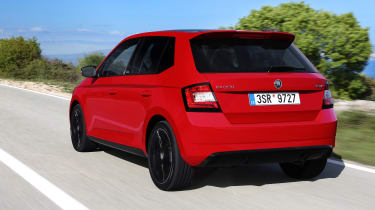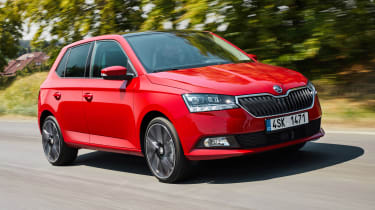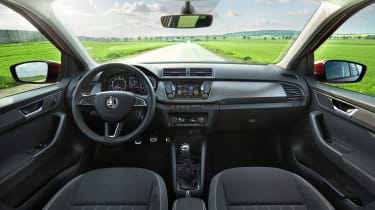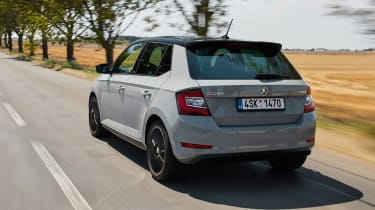2020 Skoda Fabia review – a worthy rival to the Ford Fiesta?
There are one or two reasons to buy a Fabia, but also several why you shouldn’t
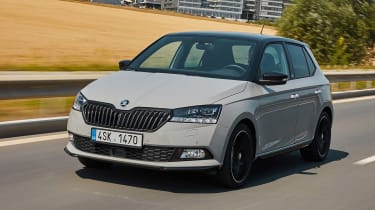
The supermini segment is more competitive than ever, with Hyundai’s third-generation i20 a promising new offering and the Ford Fiesta as accomplished as ever. The Fabia is one of Skoda’s best-selling models, but with this third-generation version now six years old, can it still compete with the best?
Since its launch in 2014, the Fabia’s rivals have taken an upward step in both refinement and tech, making the Skoda more vulnerable than its maker might like to admit. The two dominant models in the class – the Volkswagen Polo and the aforementioned Ford – are both at full strength, too, so the Fabia has its work cut out for it.
> Ford Fiesta review – still the best supermini?
On first acquaintance, the Fabia seems to offer many of the Polo’s attributes, sharing engines, transmissions and an overall VW Group sheen with its more expensive relative, but under the skin the Fabia makes do with a more higgledy-piggledy mixture of both the new and old Polo. This is felt mostly in the slightly cramped interior, which once was class leading for space, but has since been overtaken by the sixth-generation Polo and the latest SEAT Ibiza, which both have more boot space too. On the flip side, Skoda offers a Fabia estate, should you really need the extra load capacity.
More reviews
Reviews
- Skoda Fabia 130 review – 175bhp hot hatch to battle the Mini Cooper S
- 2020 Skoda Fabia review – a worthy rival to the Ford Fiesta?
- Skoda Fabia vRS (2010-2014): review, specs and buying guide
- Skoda Fabia 1.2 TSI DSG review - pictures, specifications, 0-60 time and more
- Driven: Skoda Fabia 1.2 TSI Monte Carlo
- Skoda Fabia vRS review
There is further fly in the Fabia’s ointment – as with the previous-generation version, the current model does without a hot vRS derivative. The Monte Carlo tops the range with aesthetic changes only, adding larger wheels, black trim and an uprated interior. Sports suspension can be optioned for £135, however, lowering ride height by 15mm front and rear.
Tick enough options and the Monte Carlo will nudge £25,000, but the Fabia’s real selling point is its price. The entry-level variant will set you back just £12,990 – significantly less than its key rivals. What’s more, this doesn’t come at the cost of build quality or safety.
Engine, transmission and 0-60 time
A selection of 1-litre three-cylinders are what you’ll find on the options list, comprising three turbocharged TSI units and one non-turbocharged MPI offering. They vary from the glacial 59bhp entry-level engine (the MPI) through to the range-topping 108bhp TSI. All are connected to manual gearboxes – five speeds for most and six for the top TSI – which are pleasingly slick, easy to use and with just enough notchiness to stop them feeling slack. The middling 94bhp TSI is also available with a seven-speed DSG, which is typically smooth and well sorted with only a hint of the judder and delay sometimes associated with dual-clutch gearboxes.
Performance, understandably, is not really a high priority. The 59bhp car will reach 62mph in a yawning 16.4sec, uses more fuel than the more powerful models, and is generally best avoided. The 94bhp and 108bhp turbocharged units are torquey enough to flow with traffic, but little more, hitting 62mph in 10.7 and 9.7sec respectively.
Stack these figures up against the class-leading Ford Fiesta and there’s clear room for improvement. Opt for the ST-Line X Edition and you have 153bhp and 177lb ft of torque at your disposal, enough for an 8.9sec 0-62mph time – although this model will set you back £22,205 before options.
The Fabia’s less insulated interior does allow some more of the thrummy three-pot sound to enter the cabin, mind, helping it feel a little more interactive than the new Polo at low speeds, although this might well be by accident and not design...
> Best superminis – quick compact hatchbacks reviewed and rated
Technical highlights
MacPherson struts up front and a torsion beam out back make up the basic suspension, with no form of adaptive dampers available. The ride you’re left with is relatively well sorted, though, absorbing ridges and corrugations with enough pliancy. We tried the Fabia on both 16 and 17-inch wheels and the latter didn’t seem to affect the ride quality negatively, although we’d suggest the optional 18-inch units might be a bit of overkill.
2018’s facelift brought nothing new to the driving experience, but LED headlights, an upgraded infotainment system and active safety tech such as adaptive cruise control can now be optioned – a reversing camera and a blind-spot monitoring system are also fitted in higher-specification models.
The overall design is sharp, with the Monte Carlo variant bringing gloss black wheels and trim, and a spiced-up interior with faux carbonfibre elements, red highlights and supportive sport seats. Ford’s Fiesta ST-Line does still have the edge in our eyes, however, with its striking daytime running headlights and a design inspired by the ST junior hot hatch.
Despite the Fabia’s low price, build quality is a strong point, with touchpoints solid and creaky interior trim almost entirely absent from our Monte Carlo test car – the same can’t be said for the Ford Fiesta, with scratchy plastic components to be found throughout the cabin.
What’s it like to drive?
If you’re expecting the Fabia to have an identical driving experience to something like the Polo, you’ll be surprised to hear that it doesn’t. Despite sharing much of its hardware with the Polo, the Fabia’s more rudimentary underpinnings give it a more ‘basic’ feel. Some of the VW’s slickness is gone, but what’s in its place is by no means a bad thing.
To begin with the steering has more heft to it, and although it would be a bit rich to call it feelsome, it does inspire more confidence than the lifeless Polo helm. Push a little deeper into the Fabia’s dynamic capabilities and you’ll find the ride has a slight edge over the positively cushion-like Polo’s (on standard suspension, admittedly), again increasing the sense of interaction between your inputs and the car’s responses. The Fabia is hardly as intuitive or fluid as the new Fiesta, but its somewhat basic set-up does strip away some of the Polo’s polish, only to reveal an entirely able chassis underneath.
The SEAT Ibiza is a possible snagging point, though, arguably combining the best traits from both the Ford and Volkswagen into a sharply designed little Spanish omelette, but if a lower asking price is top of your agenda, the Skoda does give you the most bang for your buck.
Price and rivals
The entry-level Fabia S starts at just £12,990 – more than £3500 less than the entry-level VW Polo or Ford Fiesta. Jump up a trim level and engine choice, and the 94bhp SE model also compares favourably at £15,810, while the equivalent SEAT Ibiza, Fiesta and Polo all sit between £17k and £18k.
Lift the budget to £16,460 and the 108bhp Fabia SE can be yours, and is also excellent value compared to its rivals. The same power in a Polo or Ibiza will set you back over £2000 more, with the Fiesta hybrid offering 123bhp for £18,110.
Often overlooked and deeply underrated is the Mazda 2, which actually undercuts the equivalent Fabia on price in some cases, but loses out where equipment is concerned. It is the far more entertaining drive, though, and in mid-spec 95bhp SEL Nav+ form is a very worthy alternative.
Other rivals such as the new Peugeot 208, Renault Clio, Citroën C3, Toyota Yaris and Nissan Micra all do slightly different things at similar price-points, but trail the class leaders. The crux of the supermini class is a pretty simple one: the Fiesta is the best to drive, the Polo is the most grown up, the Ibiza does the best compromise between the two, and the Mazda 2 is the one you should actually go out and buy. Simple.
